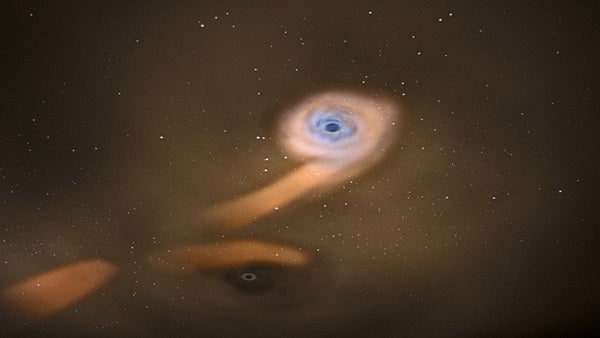Most massive galaxies in the universe are thought to harbor at least one supermassive black hole at their center. Two supermassive black holes are the smoking gun that the galaxy has merged with another. Thus, finding binary supermassive black holes can tell astronomers about how galaxies evolved into their present-day shapes and sizes.
To date, only a few candidates for close binary supermassive black holes have been found. All are in active galaxies where they are constantly ripping gas clouds apart, in the prelude to crushing them out of existence.
In the process of destruction, the gas is heated so much that it shines at many wavelengths, including X-rays. This gives the galaxy an unusually bright center and leads to it being called active. The new discovery, reported by Fukun Liu from Peking University in China and colleagues, is important because it is the first to be found in a galaxy that is not active.
“There might be a whole population of quiescent galaxies that host binary black holes in their centers,” said Stefanie Komossa. But finding them is a difficult task because in quiescent galaxies there are no gas clouds feeding the black holes, so the cores of these galaxies are truly dark.
The only hope that the astronomers have is to be looking in the right direction at the moment one of the black holes goes to work and rips a star to pieces. Such an occurrence is called a “tidal disruption event.” As the star is pulled apart by the gravity of the black hole, it gives out a flare of X-rays.
In an active galaxy, the black hole is continuously fed by gas clouds. In a quiescent galaxy, the black hole is fed by tidal disruption events that occur sporadically and are impossible to predict. So, to increase the chances of catching such an event, researchers use ESA’s X-ray observatory XMM-Newton in a novel way.
Usually, the observatory collects data from designated targets, one at a time. Once it completes an observation, it slews to the next. The trick is that during this movement, XMM-Newton keeps the instruments turned on and recording. Effectively, this surveys the sky in a random pattern, producing data that scientists can analyze for unknown or unexpected sources of X-rays.
On June 10, 2010, XMM-Newton spotted a tidal disruption event in galaxy SDSS J120136.02+300305.5, approximately 2 billion light-years away. Komossa and her colleagues were scanning the data for such events and scheduled follow-up observations just days later with XMM-Newton and NASA’s Swift satellite.
The galaxy was still spilling X-rays into space. It looked exactly like a tidal disruption event caused by a supermassive black hole, but as they tracked the slowly fading emission day after day, something strange happened.
The X-rays fell below detectable levels between days 27 and 48 after the discovery. Then they re-appeared and continued to follow a more expected fading rate, as if nothing had happened.
Now, thanks to Fukun Liu, this behavior can be explained. “This is exactly what you would expect from a pair of supermassive black holes orbiting one another,” said Liu.
Liu had been working on models of black hole binary systems that predicted a sudden plunge to darkness and then the recovery because the gravity of one of the black holes disrupted the flow of gas onto the other, temporarily depriving it of fuel to fire the X-ray flare. He found that two possible configurations were possible to reproduce the observations of J120136.
In the first, the primary black hole contains 10 million solar masses and is orbited by a black hole of about a million solar masses in an elliptical orbit. In the second solution, the primary black hole is about a million solar masses in a circular orbit.
In both cases, the separation between the black holes is relatively small: 0.6 milliparsec, or about 2 thousandths of a light-year. This is about the width of our solar system.
Being this close, the fate of this newly discovered black hole pair is sealed. They will radiate their orbital energy away, gradually spiraling together, until they merge into a single black hole in about 2 million years time.
Now that astronomers have found this first candidate for a binary black hole in a quiescent galaxy, the search is inevitably on for more. XMM-Newton will continue its slew survey. This detection also will spur interest in a network of telescopes that search the whole sky for tidal disruption events.
“Once we have detected thousands of tidal disruption events, we can begin to extract reliable statistics about the rate at which galaxies merge,” said Komossa.
When binary black holes merge, they are predicted to release a massive burst of energy into the universe — but not mostly in X-rays. “The final merger is expected to be the strongest source of gravitational waves in the universe,” said Liu.
“The innovative use of XMM-Newton’s slew observations made the detection of this binary supermassive black hole system possible,” said Norbert Schartel from ESA. “This demonstrates the important role that long-lasting space observatories have in detecting such rare events that can potentially open new areas in astronomy.”










